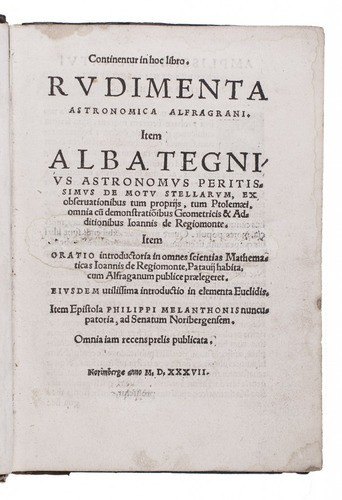Two seminal works of Arabic astronomy in their first and second (greatly revised) editions 1521
Al-Farghani (Alfraganus)
20.50 ⨯ 15.50 cm
Currently unavailable via Gallerease
- About the artworkAL-FARGHANI (ALFRAGANUS), Ahmad ibn Muhammad ibn Kathir
Continentur in hoc Iibro. Rudimenta astronomica Alfragrani.
[AL-BATTANI, Muhammad ibn Jabir]. Item Albategnius De motu stellarum, ex observationibus tum propriis, tum Ptolemaei, omnia cum demonstrationibus geometricis & additionibus Joannis de Regiomonte.
[REGIOMONTANUS, Johannes]. Item Oratio introductoria in omnes scientias mathematicas Ioannis de Regiomonte, Patavii habita, cum Alfraganum publice praelegeret. Eiusdem utilissima introductio in Elementa Euclidis.
[MELANCHTHON, Philipp]. Item Epistola Phillippi Melanthonis nuncupatoria, ad Senatum Noribergensem. Omnia iam recens prelis publicata.
Nürnberg, (colophon (2f6): Johann Petreius), 1537. With 29 woodcut diagrams and letterpress tables.
With: (2) RICCI, Agostino. De motu octavae sphaerae, opus mathematica, atq[ue] philosophia plenum. ... Eiusdam De astronomiae autoribus epistola.
Paris, Simon de Colines, 1521. 2 editions in 1 volume, the first in 2 parts. 4to (20.5 x 15.5 cm).
Both set in roman types, including small caps. Contemporary blind-tooled calf.
Binding badly damaged and spine reinforced with paper at an early date.
Two rare early editions of important astronomical works, the first combining two major Arabic works on planetary astronomy in Latin translation: the first edition of Kitab az-Zij (on the motions of the stars and particularly the planets) by al-Battani (ca. 850-929) and the second edition of Kitab fi Jawami' 'Ilm al-Nujum (an overview of the material in Ptolmey's Almagest with additions and corrections by the Arabic astronomers) by al-Farghani (ca. 800/05-ca. 870), here published for the first time with Regiomontanus's additions and geometrical proofs.
Battani was "one of the most influential astronomers of the early Islamic period. ... The accuracy of Battani's observations of equinoxes and solstices, …, is not much inferior to that of Tycho Brahe 700 years later. … His measurements of Ptolemaic solar eccentricity are "clearly better than the values found by Nicolaus Copernicus, ..., and Brahe, ...". "The indebtedness of Copernicus to al-Battani is well known. He quotes him fairly often, … Much more frequent references to him are found in Tycho Brahe's writings and in G.B. Riccioli's New Almagest; in addition, Kepler and ... Galileo evidence their interest in al-Battani's observations" (DSB). The al-Farghani was not published in Arabic until 1669 and the Battani not until the 19th century, so European knowledge of his work came largely through the present edition.
Together with the second edition of Agostino Ricci’s De motu octavae sphaerae, covering both spherical geometry and kabbala. The present edition is also an important work typographically. Colines was one of the pioneers who introduced Italian Renaissance typography to France, a movement that established many of our present idioms and was to culminate in the 1530s with books in the roman types of Claude Garamont and other great masters.
With an early purchase(?) inscription on the front paste-down and a note on the blank verso of the last leaf, but with owners' names removed from the title-page, leaving an abrasion and faint stain. Further with a tear in one leaf and some marginal stains, but otherwise internally in good condition and with generous margins. The binding is badly damaged, with most of the upper layer of the calfskin covering on the front board and spine and parts of that on the back board lost. The sewing is somewhat loose but remains attached to the sewing supports. Two important early astronomical editions.
Ad 1: Houzeau & Lancaster 764 ("fort rare"); VD16 A1202; Zinner 1655; ad 2: Houzeau & Lancaster 2355; for al-Battani and al-Farghani: DSB I, pp. 507-516 & IV, pp. 541-545. - About the artistAhmad ibn Muhammad ibn Kathir al-Farghani , also known in the West as Alfraganus (Arabic : أبو العباس أحمد بن محمد بن كثير الفرغاني ) was one of the famous astronomers in the 9th century. Born in 805 at Ferghana (present Uzbekistan), Al-Farghani worked in Baghdad where he was involved in the calculation of the diameter of the Earth together with a team of scientists under the patronage of al-Ma'mūn. Later he moved to Cairo, where he composed his important work Elements which was written between 833 and 857. The book was a readable summary of Ptolemaic astronomy and was extensively studied in Europe from the 12th to the 17th century. Two treatises on astrobes by AlFarghani also survive. Al-Farghani died around 880.
Artwork details
Related artworks
Antonie Derkinderen
Memory book Exhibition of Dutch Painting1892
Price on requestKunsthandel Pygmalion
Engelbert Kaempfer
ENGELBERT KAEMPFER BOOK1651 - 1716
Price on requestZebregs & Röell - Fine Art - Antiques
Tilmanus Nicolaus Maastricht
Missale Romanum with Dutch silver mounts1788 - 1792
Price on requestJacob J. Roosjen SRI
Tilmanus Nicolaus Maastricht
Missale Romanum with Dutch silver mounts1788 - 1792
Price on requestJacob J. Roosjen SRI
Engelbert Kaempfer
ENGELBERT KAEMPFER BOOK1651 - 1716
Price on requestZebregs & Röell - Fine Art - Antiques
Hermann Nitsch
"UNDER MY SKIN" Signed book incl. small artwork and DVD in a matching box2010 - 2014
Price on requestGallerease Selected
Antonie Derkinderen
Memory book Exhibition of Dutch Painting1892
Price on requestKunsthandel Pygmalion
Yoko Ono
YOKO ONO: "ARISING" SIGNED BOOK PLUS SMALL ARTWORK 2010 - 2014
Price on requestGallerease Selected
LAWRENCE WEINER
"SKIMMING THE WATER [MENAGE A QUATRE]" Signed book plus small artwork2010 - 2014
Price on requestGallerease Selected
1 - 4 / 22






















!["SKIMMING THE WATER [MENAGE A QUATRE]" Signed book plus small artwork by LAWRENCE WEINER](https://media-2.gallerease.com/images/442bfd5f-fc31-4e18-a2fa-ee0c08eade64/350x350/skimming-the-water-menage-a-quatre-signed-book-plus-small-artwork.jpg)